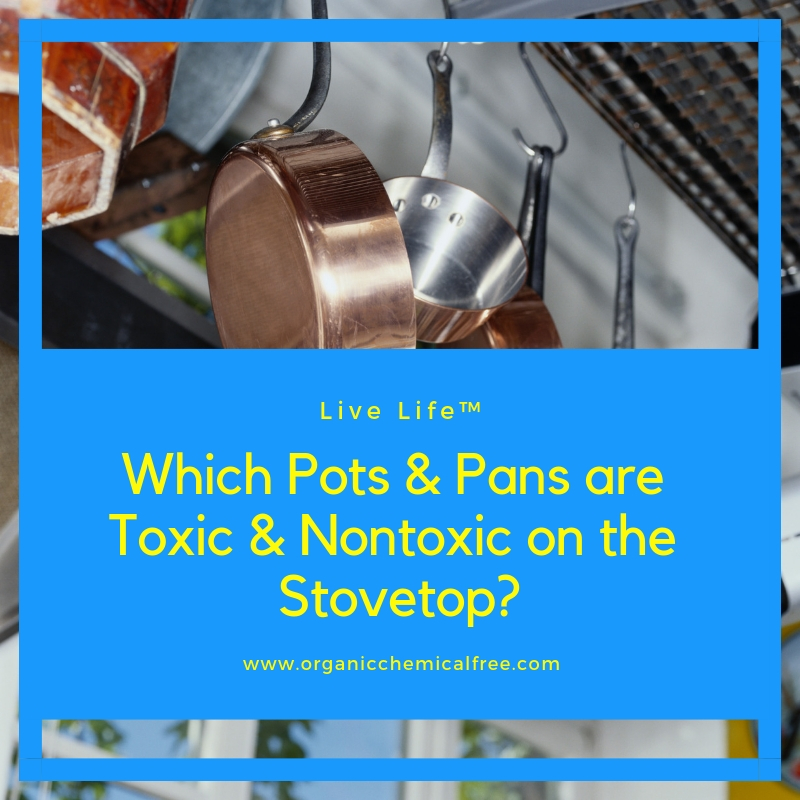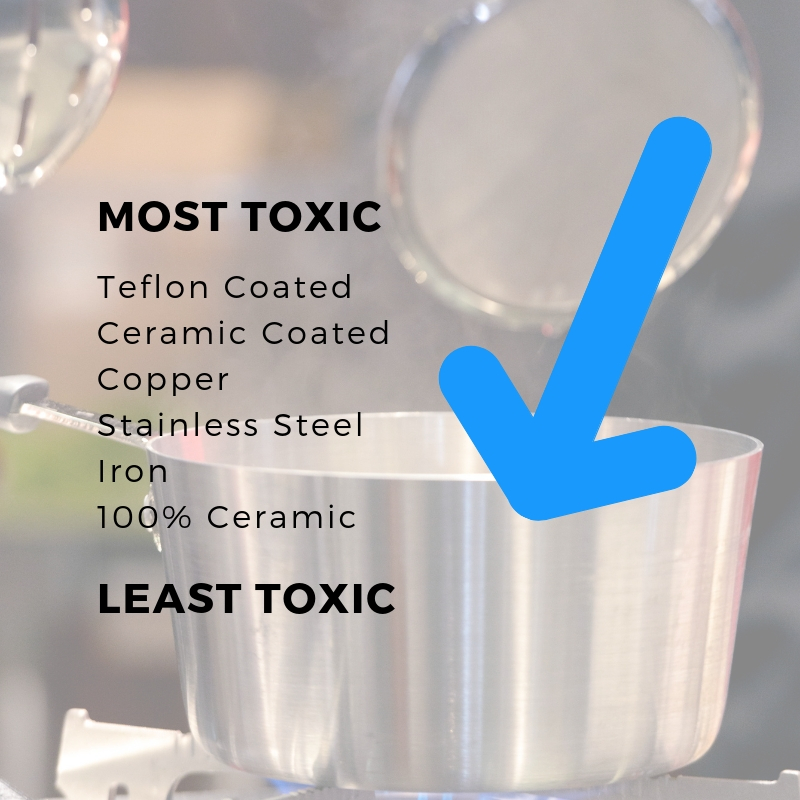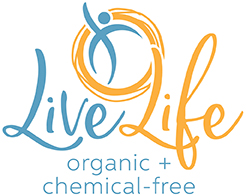
Do you faithfully buy organic food, but then ruin it by cooking with toxic pots and pans?
Chemicals and heavy metals from stove-wear can leach into our healthy food, making it less healthy.
However, healthy options are readily available. You have to know what to look for.
Want to know which pots and pans are toxic and which are nontoxic? Read on!
6 Types of Pots & Pans for the Stovetop: Toxic and Nontoxic
1.Ceramic Coated
Pots and pans that are ceramic-coated only have a thin layer of ceramic on the cooking surface, vs. made of ceramic all the way through.
The rest of the pan is made of metal (stainless steel, copper, aluminum).
The coatings may contain chemical finishes and nanoparticles, which has raised health concerns and is being studied further.
In my personal experience, these pans wear out quickly, and the surface is still somewhat sticky.
It’s not as easy to slide food off a ceramic coated pan as it is with Teflon coated.
2. Teflon Coated
Teflon coated cookware is slippery, and food, for the most part, slides right off.
However, the Teflon material itself is pretty darn harmful to health.
Found in the bodies of nearly every American tested, including unborn children, infants and young kids, chemicals in Teflon coated products may be affecting each one of us.
Chemicals used to make Teflon (including those chemicals being phased out and new replacement chemicals) have been linked, in many studies, to hormone disruption, obesity, growth and development, reproduction, thyroid function, immune system function, liver damage, and found to have adverse effects on multiple organs, endocrine activity, and lung function.
So, by using Teflon coated pans you’d be trading convenience for your family’s health.
(This goes for non-stick indoor grills, rice cookers, griddles and other cookware coated with Teflon.)
There is an alternative – another option that is slipperier than stainless steel and much healthier than Teflon.
3. 100% Ceramic
Ceramic is widely accepted as one of the healthiest materials available.
However, ceramic is not the only ingredient in 100% ceramic pans.
Pans are colored, glazed, and fired in a kiln. Glazes can contain high amounts of lead – too high for cooking food on.
Further, if the kiln was used to fire other ceramic (pottery, vases, etc.) with higher amounts of lead in the glaze, the residual lead can be transferred to any other ceramic fired in that kiln.
So, what are a few pots and pans that are not kiln fired?
4. Stainless Steel
Stainless steel and iron are tied (I’d say) for the second healthiest types of pots and pans.
While stainless steel may require a bit more olive oil to create a non-stick surface (or at least a less sticky surface), it may be worthwhile.
Cooking food on medium heat instead of high-heat can help minimize the amount of food that sticks to the pan.
(Plus, it’s healthier to cook olive oil on medium heat. Win-win!)
However, stainless steel does leach metal into foods.
The amount of leaching is related to the grade or type of stainless steel the pan (or pot) is made of.
Type 304, made of 18% chromium and 8% nickel, is the most common type.
However, Type 316 is often required for the manufacturing of food (and surgical tools). The reason? To minimize metallic contamination (or leaching).
How do you know what type of stainless steel your pots and pans are made of?
Flip ‘em over and find the number stamped on the bottom of the pot or pan. It’ll look like this: 18/8 or 18/10 (or something similar).
Other metals, like iron, may actually help to improve health.
5. Iron
Are you iron deficient? Cooking with iron can help boost your iron levels.
Which means it can also give you too much iron in your system.
Iron from pots and pans leaches into the food you’re cooking.
These heavy, thick, durable pans are ideal for long-time use and are generally viewed as being among the healthier options for stovetop cooking.
If durability and added minerals are important to you, copper pots and pans may be another option.
6. Copper
We all need a little copper in our diets. But should we be getting our copper from our stovetop cookware?
Copper pots and pans come in two varieties – all copper and a ceramic-coated copper.
The all-copper pots and pans can leach copper into foods, particularly into acidic foods such as tomato sauce. This can give food a metallic taste.
Berkley Wellness states, copper from copper pans generally isn’t a health concern.
However, as with any pots and pans that can leach metal into foods, I encourage you to decide on an individual basis if copper in your food is beneficial or a health concern for anyone eating food prepared in a copper pan.
What is the Least-Toxic Option?
If I were to rank the options for stovetop pots and pans, from most-toxic to least-toxic, this is how it would go:

When looking for the healthiest 100% ceramic pots and pans to use, look for these three things:
- 100% Ceramic
- Lead-free glaze and coloring
- Free of chemical coatings
One company that meets these criteria is Xtrema brand ceramic pots and pans (they make teapots too).
Sometimes one brand can have toxic and nontoxic products; however, the Xtrema brand cookware is made of the same materials across all products (according to their website).
This is the brand of nontoxic pots and pans that I’ve used for five years and have been very happy with.
Final Thoughts
Eating healthy food may start with buying organic, but the pots and pans you use are equally as important.
Chemicals (and heavy metals) can leach into food during cooking, turning your organic food into a chemical-filled meal.
What other products have chemicals that we don’t typically think of?
Want to learn more ways to create the best organic, chemical-free household?

Where does Calphalon rank?
Hi Lynn! Great question!
Their ceramic pans are ceramic-coated (not 100% ceramic) and have an added nonstick coating. Calphalon states that their nonstick coating is PFOA-free, which likely means that they’re using PFOA replacement chemicals. PFOA replacement chemicals have been linked to similar health effects as PFOAs; therefore I’d assume the Calphalon ceramic-coated and nonstick pots and pans may cause health effects similar to Teflon coated (and other nonstick) pans. I’d rank these alongside Teflon.
Their stainless steel (all types including the tri-ply, copper exterior and standard stainless) doesn’t mention a nonstick finish. However, they don’t say what’s specifically used in their “unique hard-anodization process” so it’s unclear if chemicals are used or would remain after anodization.